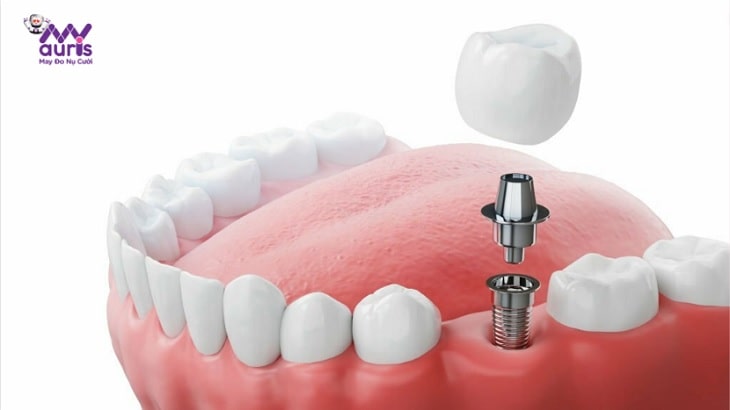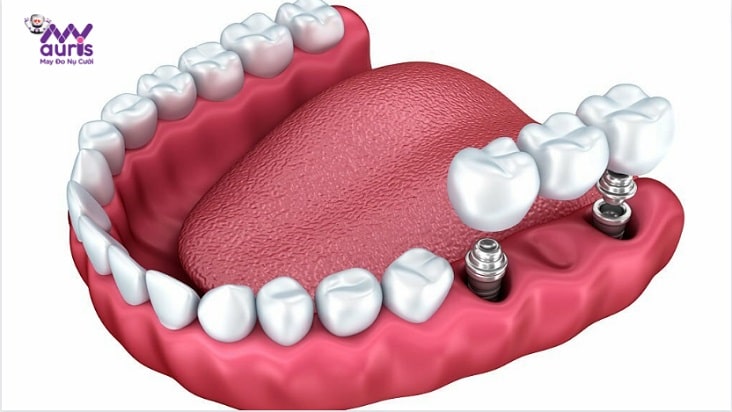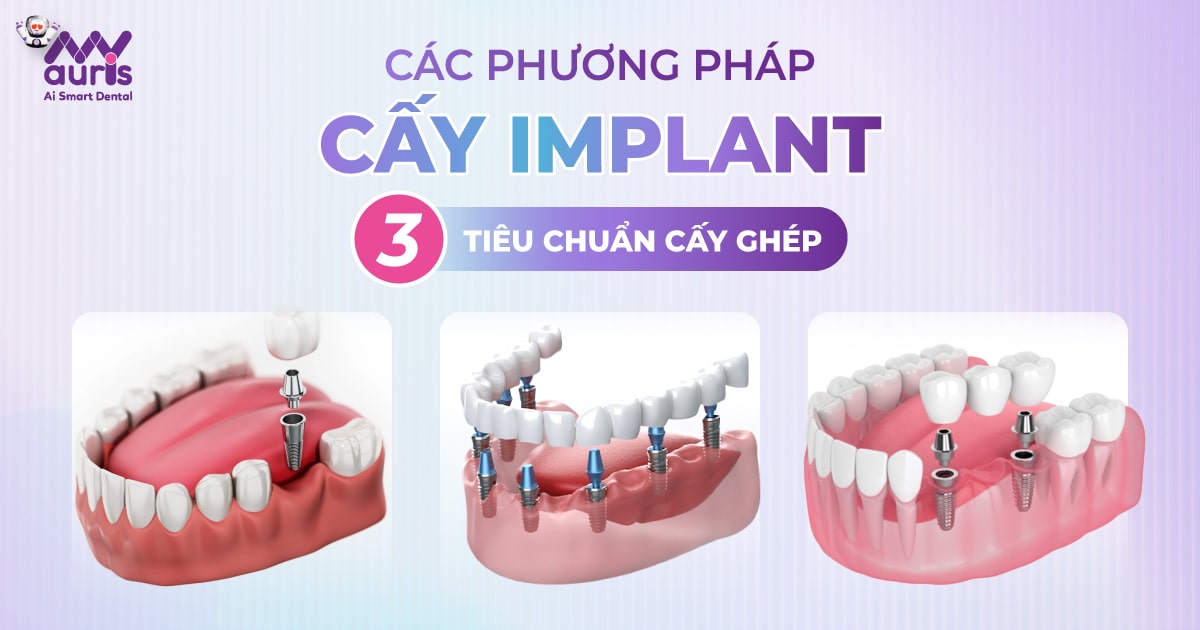Implants are an effective solution to restore lost teeth because they not only restore the aesthetics of the jaw, but also ensure the ability to chew normally. So what specific cases are implant methods used for, as well as how many steps the procedure follows according to medical standards? Let’s find out in detail through the article below!
How is implantation performed?
Implantation is a method using abutments Titanium is placed into the jawbone at the location of the lost tooth root. Then, the doctor will proceed to attach the porcelain crown on top through the abutment joint. In particular, porcelain crowns have the same shape and size as real teeth, ensuring chewing function as well as jaw aesthetics.
Furthermore, implants are a modern method of tooth implantation to restore chewing function. Not only that, dental implants also help patients become more confident in their appearance and maintain natural lines when smiling. At the same time, prevent dental diseases such as jaw bone loss when teeth are lost.
In addition, implants help restore lost teeth effectively and bring many benefits such as:
- High aesthetics: Compared to other denture implant methods, dental implants provide high aesthetics with size, shape and color similar to the color of real teeth.
- High chewing ability: By using an Implant to replace the lost tooth root, this method will be as effective as a real tooth.
- Prevent bone loss: implant helps restore lost tooth roots with titanium material. Thanks to that, this method can prevent jaw bone loss and other oral diseases such as receding gums, bad breath, etc.
- High longevity of porcelain teeth: The average lifespan of an implant ranges from 20 – 30 years, even forever if dental implants are properly cared for.

Implant implantation methods for each specific case
Currently, there are 3 methodsImplant methods include single implants, full jaw implants, and porcelain bridges on implants. Furthermore, depending on the dental condition as well as the number of missing teeth, the doctor will prescribe the appropriate method. In which:
Single implant placement
For cases of losing one or more teeth that are not fused together. At this time, you should listen to the doctor’s advice to make the appropriate choice when performing single dental implants at the lost tooth position.
Full-mouth dental implants
This is a solution to restore lost teeth in cases of full-mouth tooth loss. Besides, it helps patients have bright white teeth and chew naturally.
In case a customer loses teeth in the entire jaw, the most popular restoration technique is the All On This will help customers save costs as well as quick restoration time.
Normally, the commonly used All On From there, the doctor will provide an effective restoration solution based on the jaw bone density as well as the financial conditions of each customer.
Ceramic dental bridge on implant abutment
For cases where customers have lost 3 teeth in a row, the doctor will insert implants in the 2 outermost tooth loss positions to act as abutments to support the porcelain crown. Then, bridge porcelain crowns for all 3 teeth.

Standards that must be followed when inserting an implant
Dental implantation is a relatively difficult and complex dental technique, requiring all factors from doctors’ skills to facilities as well as modern equipment, etc. In particular, the implant placement process must be followed according to the standards of the Ministry of Health to bring about a high restoration rate. Typically:
Meeting health criteria
Checking general oral health and whole body health are extremely important and indispensable steps in the dental implant process to meet the standards.
However, in cases where patients have a history of diseases such as high blood pressure, blood clots, and heart disease.ch,.. will often be contraindicated when implanting. Because these diseases can cause conditions such as continuous bleeding, infection or even rejection of implant posts, etc., affecting oral health.
Standards of sterility when implanting
Sterile instruments, clinics, etc. need to meet the requirements of Ministry of Health on the medical industry in general and the dental industry in particular. If the tools are not sterile, cross-infection will occur during the restoration process. At the same time, it affects the results after dental implant placement.
Taking an accurate jaw impression
Taking a jaw impression is an extremely important and indispensable step in the standard dental implant steps. Taking accurate jaw impression samples will ensure that the chewing process goes smoothly and matches each patient’s bite.

Implant implantation process according to medical standards at My Auris
The implant procedure according to medical standards at My Auris requires strict adherence to the sequence of steps. A standard process will take place in 6 steps, specifically as follows:
Step 1: Examination and detailed treatment plan
My Auris Dentistry encourages patients to go to the dentist for direct consultation and examination by the doctor. At the same time, a 3D CT scan is ordered to accurately check the current tooth condition. Furthermore, the patient will do some necessary tests to meet the standard conditions for implant placement, such as measuring blood pressure, heart rate, etc. If the health condition does not meet the above conditions, the doctor will reschedule the examination for another day depending on the patient’s health or contraindications for implant placement (if any).
After having the information reviewed Tests and images, the doctor will create a treatment plan as well as advise on the appropriate type of implant. Thanks to that, it helps patients understand some specific necessary information such as the total cost of dental implants.
Step 2: Clean the oral cavity by scaling the teeth.
If you agree with the doctor’s regimen in step 1, we will begin the second process of cleaning the cavity. mouth. Besides, you need to be mentally prepared so that the implant process is not interrupted.
At this time, the doctor will perform oral hygiene to avoid infection and treatment.Treat oral diseases (if any).
Step 3: Place the implant and take a jaw sample
The doctor will separate the gum flap at the position where the implant needs to be placed. The implant placement steps are gentle and quick with a procedure time of about 7 – 10 minutes for 1 implant.
Next, the doctor will take a jaw sample and send it to the lab to make porcelain teeth.
Step 4: Install temporary teeth
After about 2 – 3 days after implant placement, you must return to the dentist according to your doctor’s appointment to have a temporary tooth attached. Temporary teeth will ensure chewing function and aesthetics while waiting for the porcelain crown on the implant.
Step 5: Follow-up examination after implant placement
After about 7 – 10 days, when the gums have healed, the patient needs to return to My Auris dentistry to check the level. degree of healing. At the same time, check your oral health one more time.
Step 6: Attach the ceramic crown to the implant post
After the implant post has integrated with the jawbone, the doctor will proceed to attach the ceramic crown to complete the dental implant process. At this point, you have teeth that are as strong as real teeth as well as ensuring the aesthetics of your jaw.
Throughout this article, there will be all the useful information and detailed answers about implantation methods. Besides, it helps you have a “steady” mentality before restoring lost teeth to improve aesthetics and chewing function. If you have questions and need answers about dental implant methods, please contact us for the most detailed advice!
Kim Dung
You may be interested in:
? Where is it safe to get implants
? What are common symptoms after implant placement?
? What are the harmful effects of dental implants?





